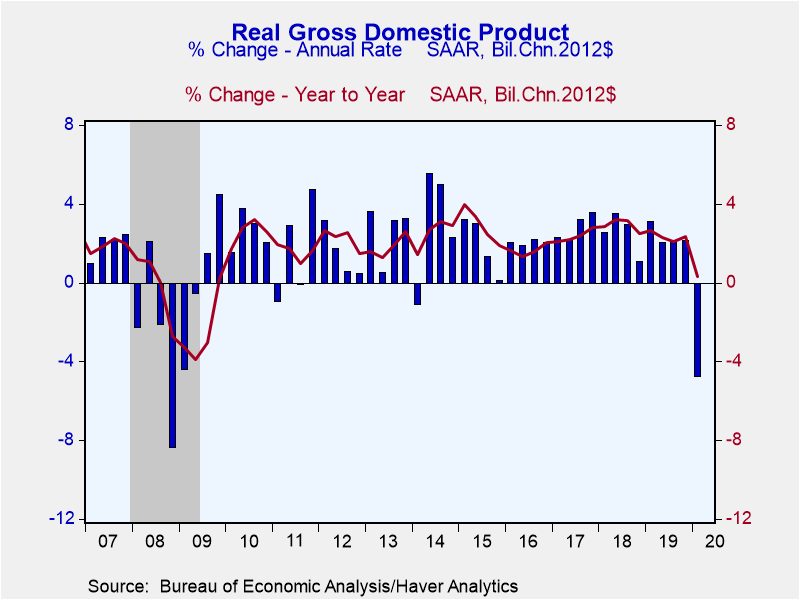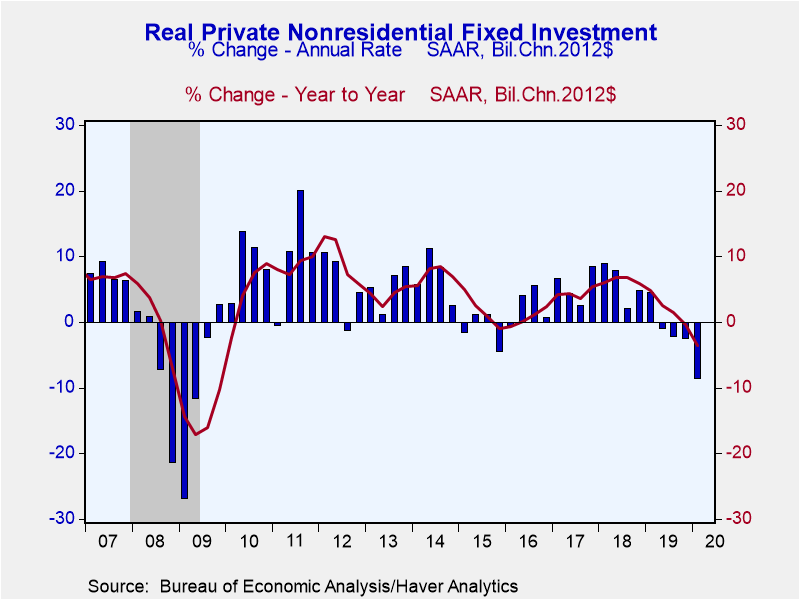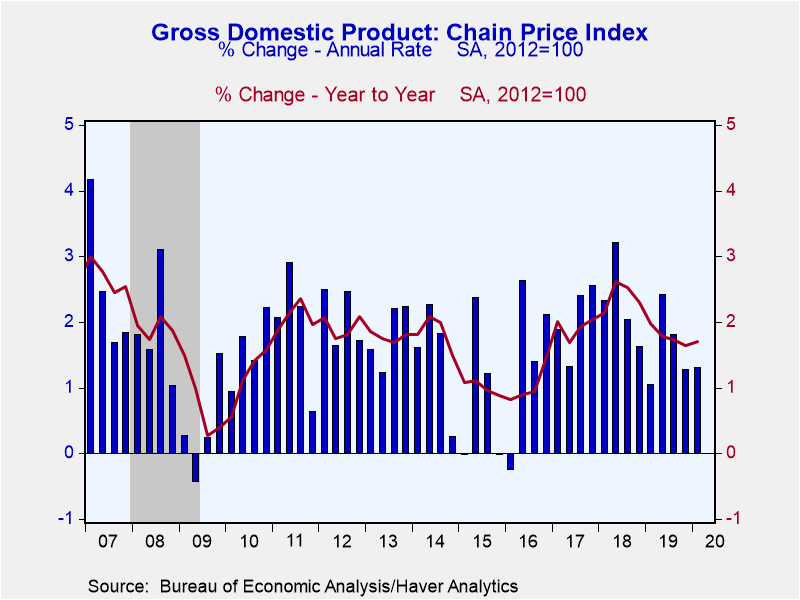 Global| Apr 29 2020
Global| Apr 29 2020U.S. GDP Growth Declines 4.8% During Q1 2020 Due to Coronavirus Work Stoppages
by:Tom Moeller
|in:Economy in Brief
Summary
U.S. GDP declined 4.8% (SAAR) last quarter following a 2.1% Q4 2019 rise. A 3.8% fall had been expected in the Action Economics Forecast Survey. The decline was the first since Q1'14 and the largest since an 8.4% drop in Q4'08. The [...]
U.S. GDP declined 4.8% (SAAR) last quarter following a 2.1% Q4 2019 rise. A 3.8% fall had been expected in the Action Economics Forecast Survey. The decline was the first since Q1'14 and the largest since an 8.4% drop in Q4'08. The work stoppages which caused the decline began only at the end of the quarter, so much larger negative effects can be expected in Q2.
The decline in activity came as domestic final sales fell 5.4% (+0.4% y/y). The shortfall was paced by a 7.6% drop (+0.4% y/y) in personal spending which reflected a 16.1% decline (+1.3% y/y) in durable goods outlays. Motor vehicle outlays fell by one-third at an annual rate (-4.3% y/y) while home furnishings & appliances outlays dropped 6.4% (+2.3% y/y) after a 1.1% rise. Spending on recreational goods & vehicles eased 0.1% (+8.8% y/y) following last year's 12.1% increase. A 6.9% improvement (4.1% y/y) in nondurable goods purchases was led by a 25.1% rise (8.2% y/y) in outlays on food & beverages. That increase was offset by a 35.9% drop (-6.9% y/y) in apparel outlays and a 5.5% decline (-2.0% y/y) in spending on gasoline & oil. Purchases of services fell an aberrant 10.2% (-0.9% y/y) as health care outlays weakened by a record 18.0% (-2.8% y/y). Recreational spending fell by roughly one-third (-6.5% y/y) while food services & hotel outlays weakened 29.7% (-6.3% y/y). Running counter to this weakness was a 2.8% rise (2.5% y/y) in spending on financial services & insurance.
Business fixed investment fell 8.6% (-3.6% y/y), down for the fourth straight quarter. Outlays of structures dropped 9.7% (-9.5% y/y), also the fourth straight quarterly decline. Investment in equipment fell 15.3% (-5.8% y/y), the fourth decline in the last five quarters. Outlays on information processing equipment weakened 15.4% (-3.9% y/y) while investment in industrial equipment declined 7.1% (-3.1% y/y), off for the second straight period. A 30.6% decline (-13.7% y/y) in transportation equipment investment was accompanied by a 0.4% rise (2.9% y/y) in intellectual property products investment, which came after 5.4% growth during the prior four quarters.
Residential investment rose 21.0% (7.0% y/y), the largest of three straight quarterly increases.
Outlays by government edged 0.7% higher (2.4% y/y), the weakest of five consecutive quarterly gains. Federal government spending rose a weakened 1.7% (4.1% y/y) as defense investment edged 0.8% higher (2.7% y/y). Nondefense outlays strengthened 3.1% (6.4% y/y). Spending by state & local government improved a negligible 0.1% (1.4% y/y) after last year's 1.6% gain.
Inventory liquidation subtracted 0.5 percentage points from GDP growth and has been holding back growth for four consecutive quarters. Net exports added 1.3 percentage points to growth as an 8.7% decline (-2.9% y/y) in exports was outpaced by a 15.3% drop (-5.8% y/y) in imports.
The GDP price index rose at a steady 1.3% annual rate (1.7% y/y) in Q1. The PCE price index also rose at a fairly steady 1.3% rate (1.6% y/y). The business fixed investment price index rose 1.2% (1.0% y/y). The residential investment price index gained 2.0% and a weakened 2.4% y/y. The government price index rose 3.2% (2.1% y/y).
The GDP figures can be found in Haver's USECON and USNA database. USNA contains virtually all of the Bureau of Economic Analysis' detail in the national accounts. Both databases include tables of the newly published not seasonally adjusted data. The Action Economics consensus estimates can be found in AS1REPNA.
| Chained 2012 $ (%, AR) | Q1'20 | Q4'19 | Q3'19 | Q1'20 Y/Y | 2019 | 2018 | 2017 |
|---|---|---|---|---|---|---|---|
| Gross Domestic Product | -4.8 | 2.1 | 2.1 | 0.3 | 2.3 | 2.9 | 2.4 |
| Inventory Effect (%-point) | -0.5 | -1.0 | 0.0 | -0.6 | 0.1 | 0.1 | 0.1 |
| Final Sales | -4.3 | 3.1 | 2.1 | 0.9 | 2.2 | 2.8 | 2.3 |
| Foreign Trade Effect (%-point) | 1.3 | 1.5 | -0.1 | 0.5 | -0.1 | -0.2 | -0.2 |
| Domestic Final Sales | -5.4 | 1.5 | 2.2 | 0.4 | 2.3 | 3.0 | 2.5 |
| Personal Consumption Expenditure | -7.6 | 1.8 | 3.1 | 0.4 | 2.6 | 3.0 | 2.6 |
| Nonresidential Fixed Investment | -8.6 | -2.5 | -2.3 | -3.6 | 2.1 | 6.4 | 4.4 |
| Residential Investment | 21.0 | 6.5 | 4.6 | 7.0 | -1.5 | -1.5 | 3.5 |
| Government Spending | 0.7 | 2.5 | 1.7 | 2.4 | 2.3 | 1.7 | 0.7 |
| Chain-Type Price Index | |||||||
| GDP | 1.3 | 1.3 | 1.8 | 1.7 | 1.8 | 2.4 | 1.9 |
| Personal Consumption Expenditure | 1.3 | 1.4 | 1.5 | 1.6 | 1.4 | 2.1 | 1.8 |
| Less Food & Energy | 1.8 | 1.3 | 2.1 | 1.8 | 1.6 | 1.9 | 1.6 |
| Nonresidential Investment | 1.2 | 0.4 | 0.5 | 1.0 | 1.2 | 1.4 | 1.0 |
| Residential Investment | 2.0 | 2.4 | 3.4 | 2.4 | 2.9 | 5.6 | 4.5 |
Tom Moeller
AuthorMore in Author Profile »Prior to joining Haver Analytics in 2000, Mr. Moeller worked as the Economist at Chancellor Capital Management from 1985 to 1999. There, he developed comprehensive economic forecasts and interpreted economic data for equity and fixed income portfolio managers. Also at Chancellor, Mr. Moeller worked as an equity analyst and was responsible for researching and rating companies in the economically sensitive automobile and housing industries for investment in Chancellor’s equity portfolio. Prior to joining Chancellor, Mr. Moeller was an Economist at Citibank from 1979 to 1984. He also analyzed pricing behavior in the metals industry for the Council on Wage and Price Stability in Washington, D.C. In 1999, Mr. Moeller received the award for most accurate forecast from the Forecasters' Club of New York. From 1990 to 1992 he was President of the New York Association for Business Economists. Mr. Moeller earned an M.B.A. in Finance from Fordham University, where he graduated in 1987. He holds a Bachelor of Arts in Economics from George Washington University.












